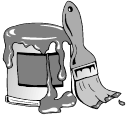I set out to strip the 30 year old paint on my front porch today thinking that, with the help of a chemical stripper, it would be as easy as erasing a chalkboard. Well, it’s not!
The Paint Stripper
Spray Stripper
I started out with a spray stripper. This product came in a 1/2 gallon can, along with a small plastic spray bottle. When I saw it at home depot, I thought it was way too good to be true. Turns out I was right.
- It was not as strong as the much thicker, gel-style stripper, which can’t be sprayed
- Because it was so thinned down, it often ricocheted off of the wood surface and back on to me (not a huge issue with the protective clothing, but it’s still worth noting.)
Gel-style Stripper
While this may not be the most common name for this type of stripper, I use it because it reminds me of the difference between regular wood stain and gel stain. It’s much thicker, and needs to be applied with a brush.
- Takes more time to apply, but works faster and stronger than spray stripper. At the end of the day, the job went faster with gel stripper. Typically, I let the gel stripper sit on the wood for about 15 minutes before attempting to scrape the paint off.
- It does “eat” your paint brush. Be sure not to use your favorite horse hair paintbrush to apply stripper. It will make the bristles very soft and unusable for painting. Purchase a dollar paint brush from your hardware store.
- Wear gloves. Even when I was being extremely careful, I found it difficult to avoid getting small amounts of stripper on my hands and arms.
The Scraper
Once the stripper had enough time to work on the old paint, it was time for the muscle work, scraping the paint.
Putty Knife
I had started scraping the paint with a putty knife. That didn’t last long. My arms tired quickly and I found myself having to reapply stripper simply because the putty knife wasn’t sharp enough to get under the paint.
Plastic Scraper
The plastic paint scraper was only $2 and worked surprisingly well. It also has a small “ledge” to help catch stripped paint as it falls off of the wood surface, making it easier to collect it in a waste container.
Metal Paint Scraper
It was a close match, but I think the metal paint scraper outperformed the plastic one by a bit. You might wonder why. The metal paint scraper actually “gummed up” after just a couple strokes. For some reason the paint, once removed, would adhere to the blade area of the scraper. So, after every two or three strokes, I’d have to remove the paint from the blade.
My suggestion is that you purchase a plastic and a metal scraper, as there certain areas that worked better with one or the other.

